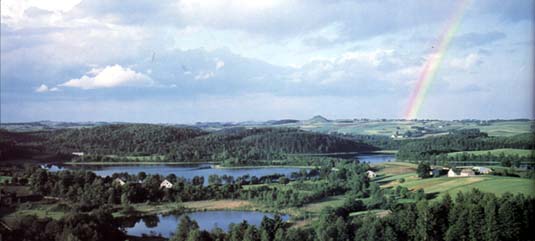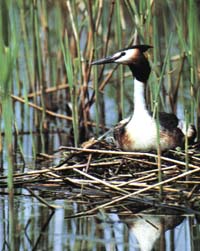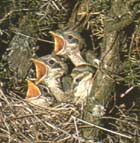

Northeastern Poland is one of the great undiscovered regions of Europe. Unspoiled by modern civilization , it is
where Poles repair to yearround. Here,wildlife still has the upper hand and humans are merely passing
through.
More than three thousand lakes known collectively as the Mazury Lake District, dot the landscape. They are the
result of the last ice age and are surrounded by primeval forests, favorite destinations of mushroom and berry pickers.
 The lakes are known for their quiet and are the perfect environment for canoeingr fishing, or just experiencing nature.
Sailboats drift gracefully across the Iakes, while kayaks and canoes ply the rivers. Poland's largest lakes, Sniardwy and
Mamry, are located in this region. The lakes are connected by rivers and canals, even by an overland rail connectian
at one paint. The most popular route is the Czarna Hancza trailr twisting for more than sixty miles from Lake Wigry to the resort
of Augustow. As you paddle along, you are witnessing untouched witderness:swans, herons and cranes ali taking refuge along
the riverbanks.
Another destination for nature lovers is the Suwalki Scenic Park, with more than twenty lakes and a varied
landscape, including a cone-shaped mountain, Cisowa Mountain. Nearby is the ancient Bialowieza forest, a Nation;
The lakes are known for their quiet and are the perfect environment for canoeingr fishing, or just experiencing nature.
Sailboats drift gracefully across the Iakes, while kayaks and canoes ply the rivers. Poland's largest lakes, Sniardwy and
Mamry, are located in this region. The lakes are connected by rivers and canals, even by an overland rail connectian
at one paint. The most popular route is the Czarna Hancza trailr twisting for more than sixty miles from Lake Wigry to the resort
of Augustow. As you paddle along, you are witnessing untouched witderness:swans, herons and cranes ali taking refuge along
the riverbanks.
Another destination for nature lovers is the Suwalki Scenic Park, with more than twenty lakes and a varied
landscape, including a cone-shaped mountain, Cisowa Mountain. Nearby is the ancient Bialowieza forest, a Nation;
 Park designated by UNESCO as a World Heritage Site.
The forest is the last natural habitat for the European bison and contains a bounty of wildlife which includes
lynx, elk, wolves, bears, and miniature horses (tarpans).
The park is an important part of Poland's ecosystem. In order to protect its inhabitants, it can only be visited
in the company of a guide, often only by horse-drawn cart.
The largest town in the region, Olsztyn, dates from the 14th century. It contains a medieval castle, once
home of Copernicus, as well as a planetarium and observatory in his honor.
Park designated by UNESCO as a World Heritage Site.
The forest is the last natural habitat for the European bison and contains a bounty of wildlife which includes
lynx, elk, wolves, bears, and miniature horses (tarpans).
The park is an important part of Poland's ecosystem. In order to protect its inhabitants, it can only be visited
in the company of a guide, often only by horse-drawn cart.
The largest town in the region, Olsztyn, dates from the 14th century. It contains a medieval castle, once
home of Copernicus, as well as a planetarium and observatory in his honor.


 The lakes are known for their quiet and are the perfect environment for canoeingr fishing, or just experiencing nature.
Sailboats drift gracefully across the Iakes, while kayaks and canoes ply the rivers. Poland's largest lakes, Sniardwy and
Mamry, are located in this region. The lakes are connected by rivers and canals, even by an overland rail connectian
at one paint. The most popular route is the Czarna Hancza trailr twisting for more than sixty miles from Lake Wigry to the resort
of Augustow. As you paddle along, you are witnessing untouched witderness:swans, herons and cranes ali taking refuge along
the riverbanks.
Another destination for nature lovers is the Suwalki Scenic Park, with more than twenty lakes and a varied
landscape, including a cone-shaped mountain, Cisowa Mountain. Nearby is the ancient Bialowieza forest, a Nation;
The lakes are known for their quiet and are the perfect environment for canoeingr fishing, or just experiencing nature.
Sailboats drift gracefully across the Iakes, while kayaks and canoes ply the rivers. Poland's largest lakes, Sniardwy and
Mamry, are located in this region. The lakes are connected by rivers and canals, even by an overland rail connectian
at one paint. The most popular route is the Czarna Hancza trailr twisting for more than sixty miles from Lake Wigry to the resort
of Augustow. As you paddle along, you are witnessing untouched witderness:swans, herons and cranes ali taking refuge along
the riverbanks.
Another destination for nature lovers is the Suwalki Scenic Park, with more than twenty lakes and a varied
landscape, including a cone-shaped mountain, Cisowa Mountain. Nearby is the ancient Bialowieza forest, a Nation;
 Park designated by UNESCO as a World Heritage Site.
The forest is the last natural habitat for the European bison and contains a bounty of wildlife which includes
lynx, elk, wolves, bears, and miniature horses (tarpans).
The park is an important part of Poland's ecosystem. In order to protect its inhabitants, it can only be visited
in the company of a guide, often only by horse-drawn cart.
The largest town in the region, Olsztyn, dates from the 14th century. It contains a medieval castle, once
home of Copernicus, as well as a planetarium and observatory in his honor.
Park designated by UNESCO as a World Heritage Site.
The forest is the last natural habitat for the European bison and contains a bounty of wildlife which includes
lynx, elk, wolves, bears, and miniature horses (tarpans).
The park is an important part of Poland's ecosystem. In order to protect its inhabitants, it can only be visited
in the company of a guide, often only by horse-drawn cart.
The largest town in the region, Olsztyn, dates from the 14th century. It contains a medieval castle, once
home of Copernicus, as well as a planetarium and observatory in his honor.